Locky decrypter (Removal Guide) - Mar 2018 update
Locky decrypter Removal Guide
What is Locky decrypter?
Locky Decrypter is a misleading data decryption tool sold by cyber criminals
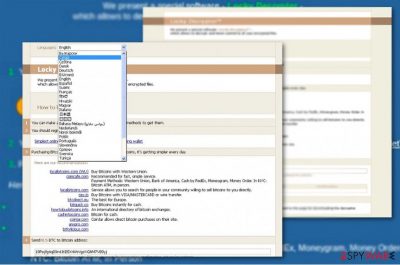
Locky Decryptor is a tool created by the same cyber criminals who developed the infamous Locky virus[1]. This decrypter is sold for 0,5, 1 or 2,5 BTC[2] for people whose files have been encrypted by .locky, .asasin, .ykcol, .diablo6, .osiris, .odin, .thor, .zepto, .shit, .aesir, .loptr or another Locky variant. Nevertheless, white hats do not recommend paying the ransom because the real locky decrypter functions might be related to malware distribution and creation of backdoors.[3]
| Name | Locky Decryptor |
| Type | Ransomware-related |
| Symptoms | Personal files locked with .locky or other Locky ransomware variant. The ransom note _Locky_recover_instructions instructs to pay Locky Decryptor |
| Distribution | This ransomware decryptor can only be purchased from Locky developers for a particular amount of Bitcoins |
| Price | Varies. Maximum demand 2.5 Bitcoins |
| Related processes | locky _decrypter.exe |
| Elimination | Locky Decryptor can download other malware or initiate system's changes to make it vulnerable. To fix that, download FortectIntego and run a full system scan with it. |
Along with the evolution of the malware, the software has been renewed as well. It presents a wide choice of alternative language options for non-native English speakers. The price for file decrypting services varies. The maximum payback about has been registered in 2016 when victims were asked to pay 2.5 BTC[2], so currently the sum in USD would exceed 8000. According to victim's reports, Locky Decrypter is currently sold for 0.25 Bitcoin.
Interestingly, that one of the latest variations, Lukitus ransomware[4], which emerged along with Diablo6 campaign, both known under one IKARUSdilapidated campaign, also uses the identical tool. Thus, it is recommended to remove Locky Decrypter right away.
Speaking about the very ransomware, Locky virus operates as a seriously dangerous ransomware that is currently spreading panic all around the world. This virus is distributed via infected email attachments, allegedly containing some invoice information. Reportedly, the virus comes in a ZIP file carrying the infected Word or JavaScript document.
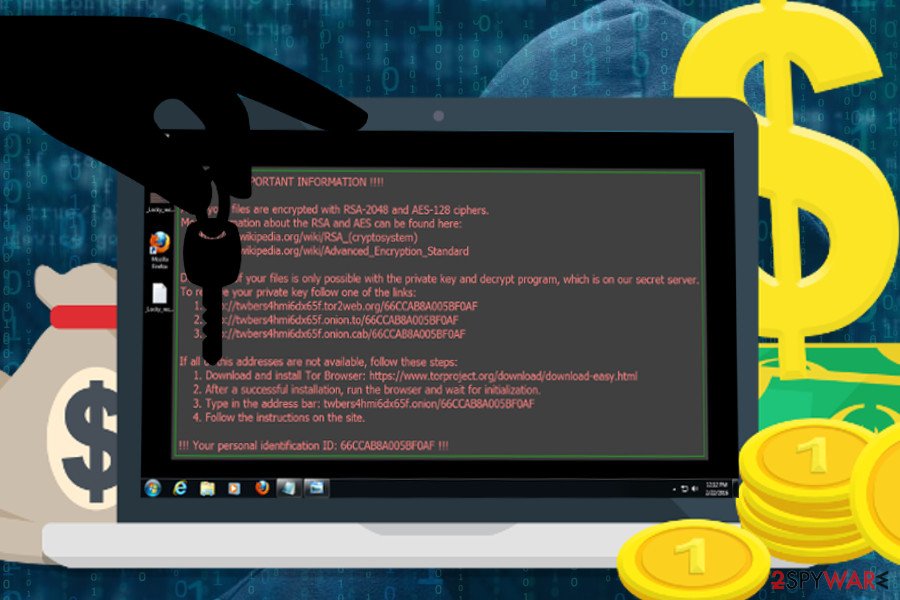
This virus is distributed via infected email attachments, allegedly containing some invoice information. Reportedly, the virus comes in a ZIP file carrying the infected Word or JavaScript document.
Once Locky gets into the victim’s computer and is activated, it starts scanning the system for a variety of different file extensions and encrypts the located files using the RSA-2048 and AES-128 algorithms. After this virus encrypts the files, it adds a .txt document, titled _Locky_recover_instructions to every folder on the computer containing the infected files.
The note explains that now, the files on the computer are locked and there is no way to unlock them without a decryption key. “Luckily”, the developers of this fraudulent program propose a solution. They offer you to buy a Locky Decrypter software which will supposedly help you to unlock the encrypted documents.
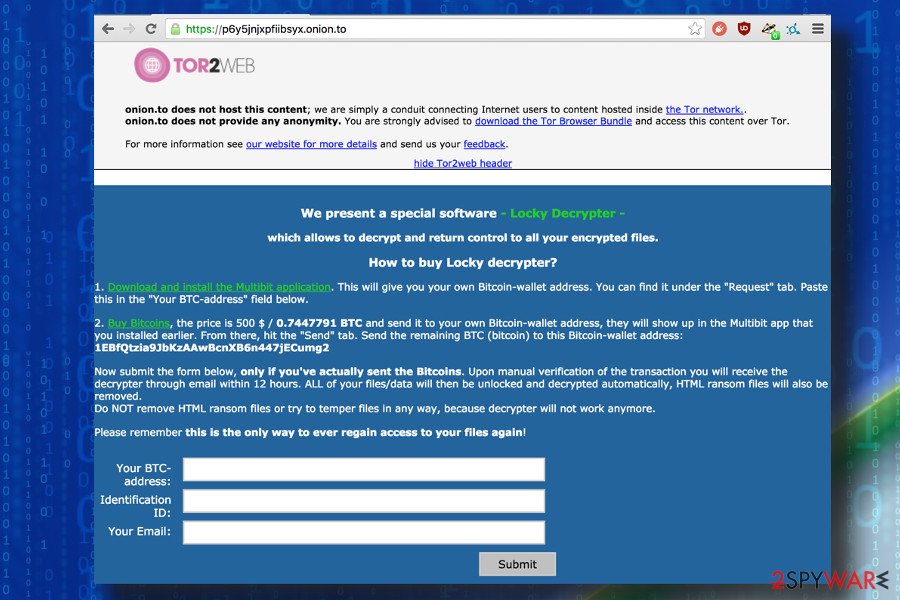
All you have to do is to connect to an anonymous Tor network and to purchase Locky Decrypter on an indicated website. Also, the victim is threatened to pay up in one week's time, or else, the price of the decrypter will double. This is pure blackmail. Therefore, Locky Decrypter removal should be performed right away.
Sadly, a lot of people opt for this option out of the desperation to retrieve their lost files. However, we highly advise you not to make any transactions, because you are dealing with cyber criminals, so there is no guarantee that the tool will decrypt locky ransomware. In this case, you'll be left with no data and no money.
You may need to spend more than $300 or even $600 (which equal 0,5 and 1 bitcoin respectively) for it. What is more, even if you receive the promised software, you cannot be sure if it will successfully decrypt the files. Therefore, if you are infected with this virus, it is better that you remove it immediately rather than try to buy out your files.
By doing that, you only support the scammers and their malicious future creations. We recommend using a reputable antivirus like FortectIntego or Malwarebytes to remove Locky ransomware and its decrypter from your computer. 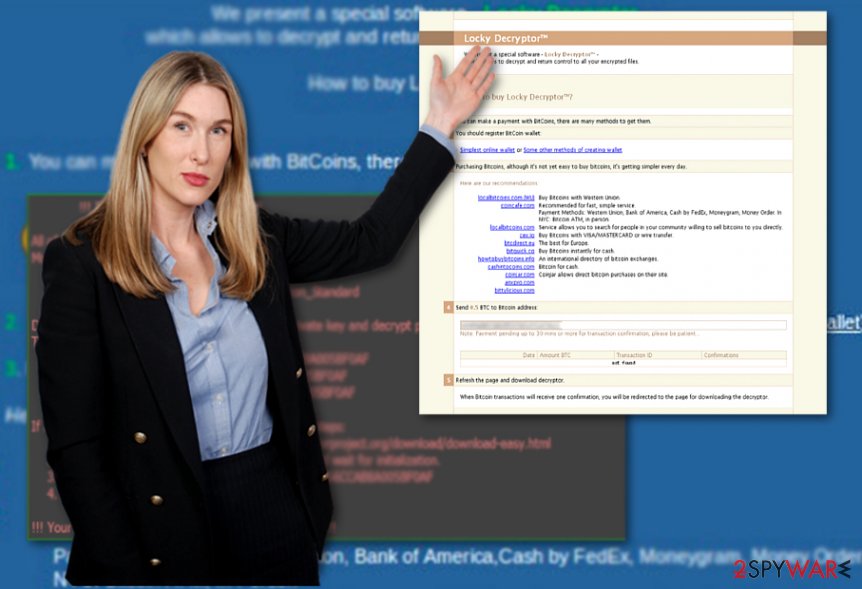
Promotion ways
Once you open the ransom note, you will notice multiple links to the websites, where you can obtain the Locky Decrypter. The decryptor can only be downloaded from websites, accessible through an anonymous Tor network, which is favoured by a variety of online scammers, hackers, and other crooks.
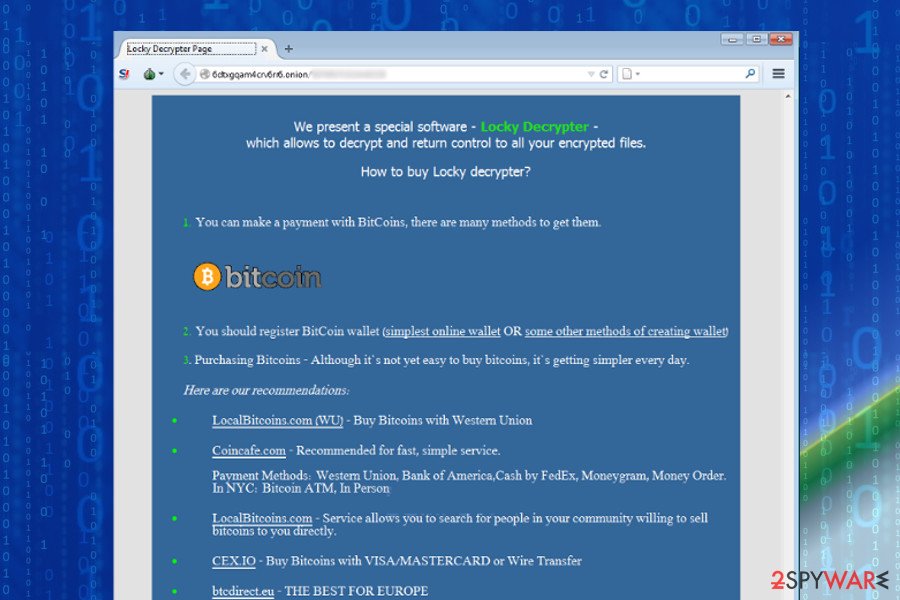
It is extremely dangerous to interact with any of these links because they may redirect you to some other infectious websites and contaminate your system with trojans, viruses, and worms. Note that deleting .locky decrypter or locky _decrypter.exe files will not help eradicate the very malware.
More information is provided below. Therefore, it is wiser to initiate about Locky removal than risk causing your computer additional problems.
Get rid of Locky Decrypter
The functionality of Locky Decryptor is highly questionable. Nevertheless, even if you have already purchased the program and managed to decrypt your files, we highly recommend you to remove Locky Decrypter virus along with the Locky virus from your system. To do that, you can follow three fundamentals steps.
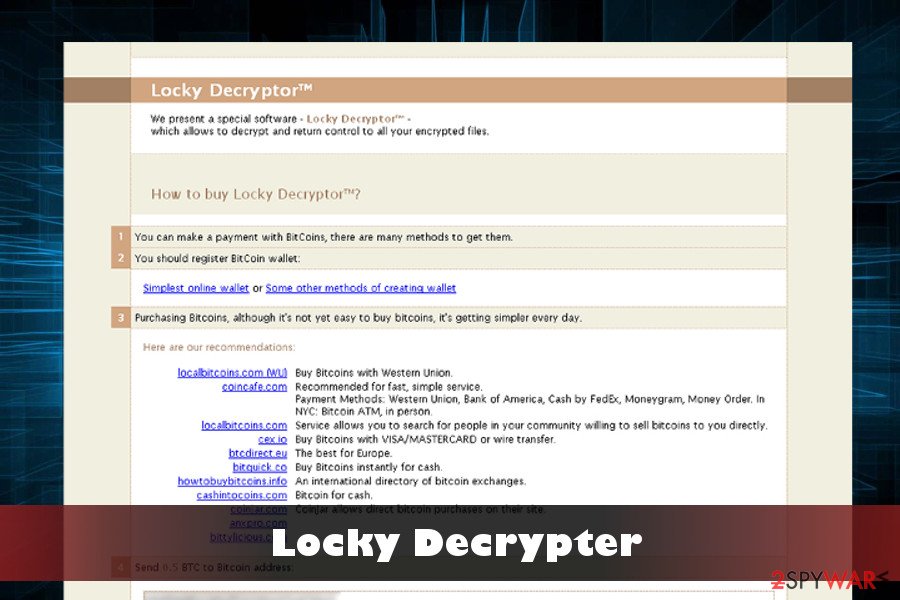
First, you should obtain a reputable antivirus tool, such as FortectIntego or Malwarebytes. Then, disconnect your PC from the network because your computer may be more vulnerable to the Locky processes when it is online.
Lastly, run a thorough scan of your system with the obtained antivirus software, which will detect and remove Locky virus and all of its components from your machine. If you are experiencing any difficulties, you can also check the Locky removal guide also provided on our website.
Getting rid of Locky decrypter. Follow these steps
Manual removal using Safe Mode
You will likely need to reboot the system in Safe Mode to delete Locky Decrypter tool and the malware.
Important! →
Manual removal guide might be too complicated for regular computer users. It requires advanced IT knowledge to be performed correctly (if vital system files are removed or damaged, it might result in full Windows compromise), and it also might take hours to complete. Therefore, we highly advise using the automatic method provided above instead.
Step 1. Access Safe Mode with Networking
Manual malware removal should be best performed in the Safe Mode environment.
Windows 7 / Vista / XP
- Click Start > Shutdown > Restart > OK.
- When your computer becomes active, start pressing F8 button (if that does not work, try F2, F12, Del, etc. – it all depends on your motherboard model) multiple times until you see the Advanced Boot Options window.
- Select Safe Mode with Networking from the list.

Windows 10 / Windows 8
- Right-click on Start button and select Settings.

- Scroll down to pick Update & Security.

- On the left side of the window, pick Recovery.
- Now scroll down to find Advanced Startup section.
- Click Restart now.

- Select Troubleshoot.

- Go to Advanced options.

- Select Startup Settings.

- Press Restart.
- Now press 5 or click 5) Enable Safe Mode with Networking.

Step 2. Shut down suspicious processes
Windows Task Manager is a useful tool that shows all the processes running in the background. If malware is running a process, you need to shut it down:
- Press Ctrl + Shift + Esc on your keyboard to open Windows Task Manager.
- Click on More details.

- Scroll down to Background processes section, and look for anything suspicious.
- Right-click and select Open file location.

- Go back to the process, right-click and pick End Task.

- Delete the contents of the malicious folder.
Step 3. Check program Startup
- Press Ctrl + Shift + Esc on your keyboard to open Windows Task Manager.
- Go to Startup tab.
- Right-click on the suspicious program and pick Disable.

Step 4. Delete virus files
Malware-related files can be found in various places within your computer. Here are instructions that could help you find them:
- Type in Disk Cleanup in Windows search and press Enter.

- Select the drive you want to clean (C: is your main drive by default and is likely to be the one that has malicious files in).
- Scroll through the Files to delete list and select the following:
Temporary Internet Files
Downloads
Recycle Bin
Temporary files - Pick Clean up system files.

- You can also look for other malicious files hidden in the following folders (type these entries in Windows Search and press Enter):
%AppData%
%LocalAppData%
%ProgramData%
%WinDir%
After you are finished, reboot the PC in normal mode.
Remove Locky decrypter using System Restore
-
Step 1: Reboot your computer to Safe Mode with Command Prompt
Windows 7 / Vista / XP- Click Start → Shutdown → Restart → OK.
- When your computer becomes active, start pressing F8 multiple times until you see the Advanced Boot Options window.
-
Select Command Prompt from the list

Windows 10 / Windows 8- Press the Power button at the Windows login screen. Now press and hold Shift, which is on your keyboard, and click Restart..
- Now select Troubleshoot → Advanced options → Startup Settings and finally press Restart.
-
Once your computer becomes active, select Enable Safe Mode with Command Prompt in Startup Settings window.

-
Step 2: Restore your system files and settings
-
Once the Command Prompt window shows up, enter cd restore and click Enter.

-
Now type rstrui.exe and press Enter again..

-
When a new window shows up, click Next and select your restore point that is prior the infiltration of Locky decrypter. After doing that, click Next.


-
Now click Yes to start system restore.

-
Once the Command Prompt window shows up, enter cd restore and click Enter.
Bonus: Recover your data
Guide which is presented above is supposed to help you remove Locky decrypter from your computer. To recover your encrypted files, we recommend using a detailed guide prepared by 2-spyware.com security experts.If your files are encrypted by Locky decrypter, you can use several methods to restore them:
What is Data Recovery Pro?
In case you did not tback up your files and ran out of options, you may give this software a try. It is created for restoring damaged files.
- Download Data Recovery Pro;
- Follow the steps of Data Recovery Setup and install the program on your computer;
- Launch it and scan your computer for files encrypted by Locky decrypter ransomware;
- Restore them.
Previous Windows Versions
If you tend to create System Restore Points on a regular basis, you may succeed in data recovery from the previous Windows versions.
- Find an encrypted file you need to restore and right-click on it;
- Select “Properties” and go to “Previous versions” tab;
- Here, check each of available copies of the file in “Folder versions”. You should select the version you want to recover and click “Restore”.
Try ShadowExplorer
That's yet another third-party data recovery tool that can extort Volume Shadow Copies from your PC and restore the files subsequently. However, it will work only if the virus fails to remove Volume Shadow Copies.
- Download Shadow Explorer (http://shadowexplorer.com/);
- Follow a Shadow Explorer Setup Wizard and install this application on your computer;
- Launch the program and go through the drop down menu on the top left corner to select the disk of your encrypted data. Check what folders are there;
- Right-click on the folder you want to restore and select “Export”. You can also select where you want it to be stored.
Finally, you should always think about the protection of crypto-ransomwares. In order to protect your computer from Locky decrypter and other ransomwares, use a reputable anti-spyware, such as FortectIntego, SpyHunter 5Combo Cleaner or Malwarebytes
How to prevent from getting ransomware
Choose a proper web browser and improve your safety with a VPN tool
Online spying has got momentum in recent years and people are getting more and more interested in how to protect their privacy online. One of the basic means to add a layer of security – choose the most private and secure web browser. Although web browsers can't grant full privacy protection and security, some of them are much better at sandboxing, HTTPS upgrading, active content blocking, tracking blocking, phishing protection, and similar privacy-oriented features. However, if you want true anonymity, we suggest you employ a powerful Private Internet Access VPN – it can encrypt all the traffic that comes and goes out of your computer, preventing tracking completely.
Lost your files? Use data recovery software
While some files located on any computer are replaceable or useless, others can be extremely valuable. Family photos, work documents, school projects – these are types of files that we don't want to lose. Unfortunately, there are many ways how unexpected data loss can occur: power cuts, Blue Screen of Death errors, hardware failures, crypto-malware attack, or even accidental deletion.
To ensure that all the files remain intact, you should prepare regular data backups. You can choose cloud-based or physical copies you could restore from later in case of a disaster. If your backups were lost as well or you never bothered to prepare any, Data Recovery Pro can be your only hope to retrieve your invaluable files.
- ^ Catalin Cimpanu. Boobytrapped Word File Installs Locky Ransomware When You Close the Document. BleepingComputer. News, reviews and tech support.
- ^ Pancak3. Price of Locky decryptor is increasing, likely due to recent heist; they're asking for 2.5 BTC now. Twitter. Online Source for News and Communication.
- ^ Liam Tung. Researchers say Intel's Management Engine feature can be switched off. ZDNet. Technology News, Analysis, Comments, and Product Reviews for IT professionals.
- ^ Lawrence Abrams. Locky Ransomware switches to the Lukitus extension for Encrypted Files. BleepingComputer. News, reviews and tech support.





















